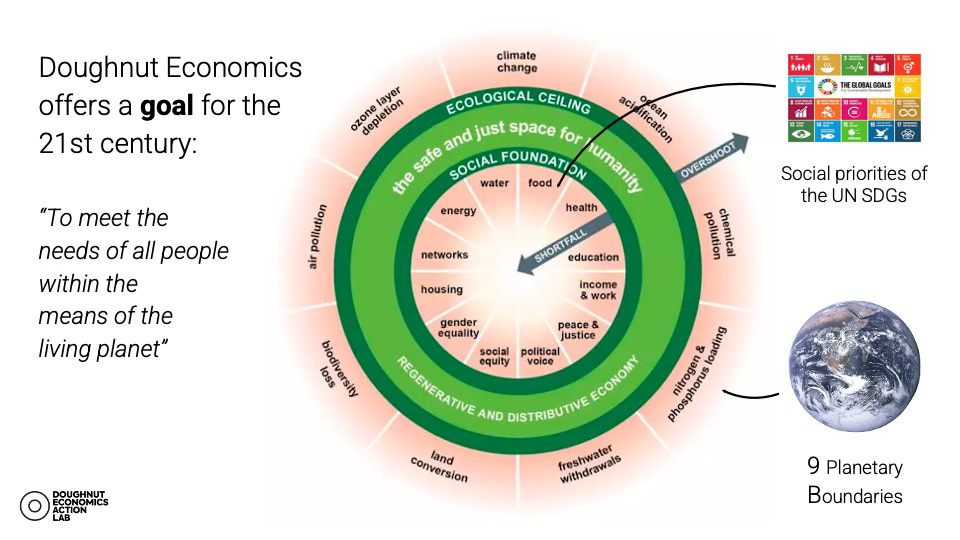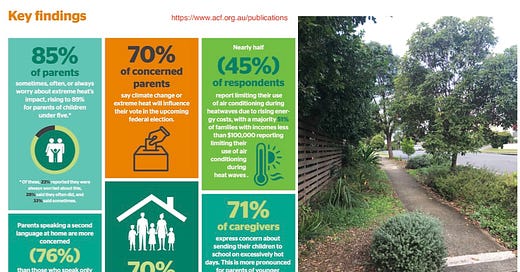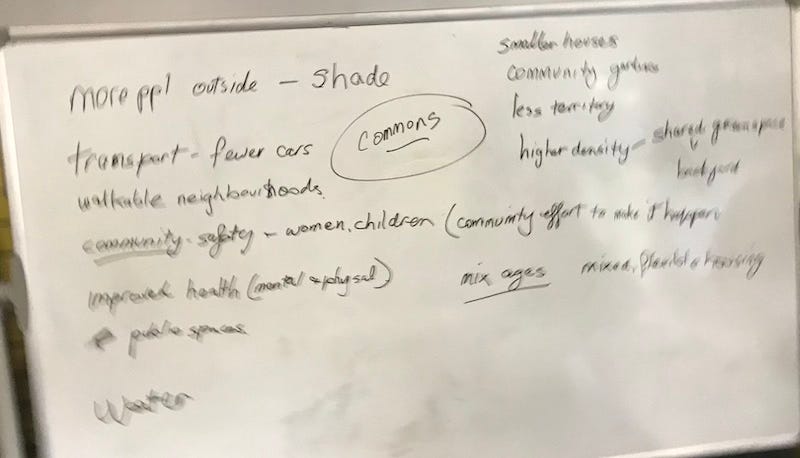February Workshop: Urban Heat and Heat Islands
This was the first of our workshops where we bring together a diverse group of people to discuss a topical issue within the framework of Doughnut Economic and Strategic Doing.
On a hot Sunday afternoon in February 2025, a very diverse group came together for a challenging and fast-paced workshop on Heatwaves and Urban Heat Islands and how we might mitigate or adapt to increasing heat in our region. The workshop was hosted by ACF Community Brisbane Northside, the Shady Lanes Project, and Regen Brisbane.
At what we hope is the tail end of a scorching summer, nobody needed convincing that increasing heat and heatwaves is a significant problem.
In these workshops, we aim to move the conversation from:
Someone Ought to DO something
to
What can I DO to make a difference?
and
What can WE DO to make a difference?
We drew on the framework of Doughnut Economics and the methods of Strategic Doing. (see more here or see the slides and recording of our Global Donut Days presentation)

We started with a Framing Question
What if the people of Brisbane worked together to create a cooler, greener, shadier, and thriving city where everyone is safe from the effects of heatwaves and urban heat islands.
What would success look like?
We included “thriving” so it includes business, employment, health, education, nature, and whatever else you think is necessary to qualify a city as thriving. And “everyone” which means nobody is left in the “shortfall” centre of the donut. This is a reflection of Doughnut Economics.
This form of question (appreciative inquiry) can be very challenging because we are accustomed to the more linear way of proposing a solution to a narrowly-defined problem. For example, “we need to reduce emissions to stop rising temperatures”, “we need to design our houses better to cope with the heat”, or “the government should legislate to...”
It took a few minutes but once the conversation got going, the ideas began to flow. Here are some that I wrote on the whiteboard. Perhaps, participants wrote more down on their notes.
One thing that emerged early was the idea that people would spend more time outside in cool, green, public, shared spaces. There would be more people outdoors.
Community was mentioned many times. Success included safety for all ages, women, and children. Fewer cars, walkable neighbourhoods, community gardens.
Public greenspace (commons) might be a good option for some play and shared activities compared to the isolated backyard. We might become less territorial with less focus on having big houses.
Improved mental and physical health from a more active lifestyle and connections to nature and others in the community.
This was a good reminder about how interlinked all these issues are. We can’t address any problem in isolation.
Having generated a shared and still evolving vision of where we wanted to go, we moved on to the next question: How do we get there?
How do we get there?
We start with what we’ve got. This is called uncovering our assets in Strategic Doing.
We talked about what we each brought to the table. I won’t name individuals here, but between us we brought:
connections in the local community, online and offline
interest in ideas and practice in drawing connections between them
participation and networks in bushcare groups
professional and academic expertise in sustainability, urban heat, transport, urban planning, architecture, communication, marketing
existing verge gardening projects with monthly verge visits
strong interests in sustainability and social equity
And we have access to:
Support and use of the library room via
and links into the national Australian Conservation Foundation (ACF)The ACF Community Brisbane Northside and Regen Brisbane networks, with our respective Substack websites, newsletters, and audiences
The Doughnut Economics Action Lab (DEAL) website, materials, and network
Several of us have our own individual Substacks
- materials and the ongoing verge garden projects
External opportunities include:
Interest in the topic built by current campaigns like the Extreme Heat Awareness Day and the ACF campaign on Urban Heat.
Verge Garden Visit at Banyo - One verge visit per month. Next one 15th March.
Plans for a stall in the Community Corner at the Sustainable BNE Festival in May
Option of a stall at Banyo for Queensland Day in June
Platypus-themed event in September - when our next summer is looming
Global Doughnut Days in November TBC
We also noted that for many materials we don’t need to create them, simply link to those already online.
Then we moved on to how might we combine some of that jumble of assets to do more together than any of us can do alone.
Combining Assets
Projects form and evolve depending on the assets participants in the network choose to contribute, outside opportunities, and how they combine all of that to do more.
A “concrete” example of combining assets is our verge gardens (council + resident + nature)
The land is available, in front of our homes, we already mow it, and it is public
The council policy provides the permission and boundaries - and a street tree
Shady Lanes Project provides information and guidance
A local community nursery is a source of native tubestock and advice on which local plants are suitable
A group project provides examples and support
Groups can share experience and resources
A productive verge project benefits councils (thriving street trees), residents (shady and pleasant streets), and nature (biodiversity and habitat). Another important outcome is that it builds trust and relationships between councils and residents, and between residents and their neighbours. If you are doing it as a group, it can also strengthen relationships within your group.
We used the diagrams from this post to think about how plans in these turbulent, unpredictable situations don’t fit standard linear planning processes.
Progress for complex problems in an unpredictable world is more like this where we make a series of steps. We need flexibility to adapt and incorporate what we learn as we go, and take advantage when unpredictable opportunities arise. From the outside, this can look like making it up as you go along. Our shared purpose and carefully managed conversations keep us moving working together.
At each step, we:
confirm and refine our shared purpose (where we want to go).
reflect on the past step and what we have learned, and go through this same process to decide “What’s Next?”
make sure all our steps are taking us in the right direction
The key is doing things together with a series of small wins (that gradually get bigger)
What Could We Do With Our Assets?
How might we link and leverage the assets we’d just identified to get to this cooler, greener, place we’d collectively imagined.
These are some of the ideas people came up with:
It was generally agreed that we have to win hearts and minds. But how? Some ideas were:
debates, podcasts, humour and comedy events
street parties
all of us plant our verge garden, write stories about it, hold verge visits
put in positive submissions for good projects to counter all the negative submissions
celebrate the good work being done and tell people why it is good
build alliances between professionals and the public
community education
a large event / forum / Hack-a-thon style event to bring public and professionals together
There were plenty of big ideas, so it was time to narrow it down
What Should We do?
Dealbreakers: The activities must:
Be doable now with what we’ve got? (some could go on hold until doable)
Take us in the right direction?
Design: To be effective, activities should be:
Explicit and visible
Big enough to make an impact and get noticed
Small enough to be fairly sure of success (small wins build trust and momentum)
Maximise Value (Leverage): questions to decide what is most worth doing
What outcomes can we expect?
Are we building more assets that we can leverage?
How can we get the most benefit for the least expense?
What Will We Do Next?
continue this discussion online with articles and comments
add a section to the Regen Brisbane section listing submissions and other items of interest regarding heat
explore the idea of working with other organisations for hack-a-thon style events
some participants want to learn more about using Substack
Verge Garden Visit at Banyo on 15th March - This garden was the site of some earlier working bees as part of the Banyo Project and is now two years old.
Regen Brisbane and ACF Community Brisbane Northside core teams to each reflect on this workshop, write up their respective posts on the meeting, and decide whether to continue this topic or add a related topic for the next workshop on 16th March.
You can register early for next month’s workshop here. The topic is to be confirmed.
Thanks to:
Jenny for mentioning this workshop and repeating the framing question in a comment on Facebook https://www.facebook.com/share/p/1F9GPK9RXy/
Robyn for her Substack post: From High Ground to Hot Mess and cross-posting here on Regen Brisbane
Ryan for his Substack post: Building community + town planning coalitions for cooler cities






There is no mode data recorded on temperatures. Only min and max readings
An individual can't collect the mode temperature data - it will only be seen as being manipulated if it is collected by an individual. Realistically it can only be done by the Weather Bureau but that relies on government funding which I suspect the Weather Bureau does not have. You need to get government on side to obtain funds and in turn collect the data. Even if that data is collected by a regrettable organisation, it will still be challenged as we live in a society that runs on true data that is classified as fake data and so not correct such as (in this case) only looking at the max temperature and not the temperature that mostly occurs in a day and that has changed over time. If a local political representative is not willing to take up the above, then you need to run for Parliament. Laws in the long term get things done until they themselves are changed into other laws.